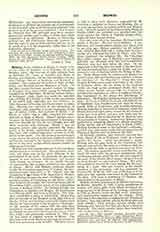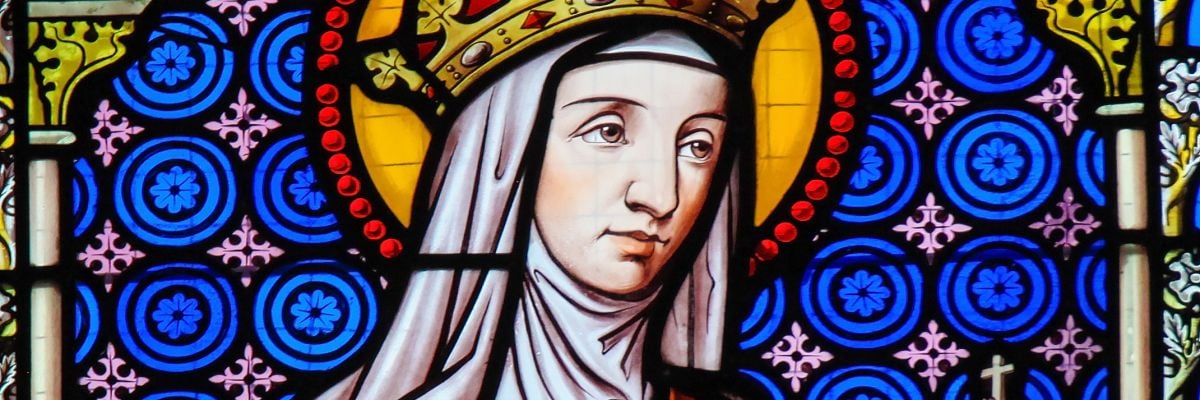

Hedwig, Saint, Duchess of Silesia, b. about 1174, at the castle of Andechs; d. at Trebnitz, 12 or October 15, 1243. She was one of eight children born to Berthold IV, Count of Andechs and Duke of Croatia and Dalmatia. Of her four brothers, two became bishops, Ekbert of Bamberg, and Berthold of Aquileia; Otto succeeded his father as Duke of Dalmatia, and Heinrich became Margrave of Istria. Of her three sisters, Gertrude married Andrew II, King of Hungary, from which union sprang St. Elizabeth, Landgravine of Thuringia; Mechtilde became Abbess of Kitzingen; while Agnes was made the unlawful wife of Philip II of France in 1196, on the repudiation of his lawful wife, Ingeborg, but was dismissed in 1200, Innocent III having laid France under an interdict. Hedwig was educated at the monastery of Kitzingen, and, according to an old biography, at the age of twelve (1186), was married to Henry I of Silesia (b. 1168), who in 1202 succeeded his father Boleslaw as Duke of Silesia. Henry’s mother was a German; he himself had been educated in Germany; and now through his wife he was brought into still closer relations with Germany. Henry I was an energetic prince, who greatly extended the boundaries of his duchy, established his authority on a firm basis, and rendered important services to civilization in the realm. For this purpose he encouraged to the utmost the spread of the more highly developed civilization existing in the German territories adjoining his to the west, so that Silesia became German in language and customs.
Hedwig now took a prominent part in the beneficent administration of her husband. Her prudence, fortitude, and piety won for her great influence in the government of the land. In particular she gave her support to new monastic foundations and assisted those already in existence. It was chiefly through the monasteries that German civilization was spread in Silesia. Henry and Hedwig endowed munificently the Cistercian monastery of Leubus, the Premonstratensian monastery of St. Vincent, and the foundation of the Canons of St. Augustine at Breslau. The following monasteries were established: the Augustinian priory of Naumburg on the Bober (1217), later transferred to Sagan, the Cistercian monastery of Heinrichau (1227), and the priory of the Augustinian Canons at Kamenz (1210). St. Hedwig brought the Dominicans to Bunzlau and Breslau, the Franciscans to Goldberg (1212) and later to Krossen. The Templars established a house at Klein-Gels. Henry was also the founder of the Hospital of the Holy Ghost at Breslau (1214), and Hedwig tended with disinterested charity the leper women in the hospital at Neumarkt. At the instance of his saintly wife, the duke then founded at his own expense, and on ground donated by himself the convent of the Cistercian nuns at Trebnitz (1202), and generously endowed it. This was the first house of religious women in Silesia. The first nuns came from Bamberg and took possession of their new monastery early in 1203. The first abbess is said to have been Petrussa, succeeded by Bl. Gertrude, a daughter of Henry and Hedwig, who at an early age had been betrothed to Otto von Wittelsbach. After he murdered the German King Philip of Swabia (1208), the betrothal was annulled and Gertrude entered the Abbey of Trebnitz (before 1212), where she later became abbess.
For some years after her marriage, Hedwig resided chiefly at Breslau. She had seven children. A son, Boleslaw, and two daughters, Sophia and Agnes, died at an early age; Henry succeeded to his father’s title; Conrad died while still a young man, in consequence of a fall from his horse (c. 1214); and Gertrude embraced the religious life. On Christmas Day, 1208, another son of Hedwig’s was baptized, probably not identical with the above-mentioned Boleslaw, who had died before this time. On the suggestion of Hedwig, after the birth of this last child, she and her husband led a virgin life (1209), and pronounced a vow of chastity before the Bishop of Breslau. Duke Henry took the tonsure and allowed his beard to grow, like the Cistercian lay brothers (whence his sobriquet of “the Bearded”). From this time forward Hedwig spent much of her time at the Abbey of Trebnitz, where, on the death of her husband (1238), she took up her permanent abode, that she might devote herself unreservedly to exercises of mortification and piety as well as to works of charity. She transferred to the abbey her inheritance of Schawoine. Hedwig had had many trials and tribulations. In the year 1227 her husband, with Duke Lesko of Sandomir, was treacherously set upon by Swantopolk, Duke of Pomerania, and severely wounded. Hedwig immediately hastened to Gonsawa, where the bloody deed had taken place, to care for her husband. Lesko had been killed, and war now broke out between Henry of Silesia and Conrad of Masovia over the possession of Cracow. Conrad was defeated, but succeeded in surprising Henry in a church attending Divine service and led him captive to Plock (1229). Hedwig forthwith went to her husband’s assistance, and her very appearance made such an impression on Conrad of Masovia that he released the duke.
Of Hedwig’s children, only Gertrude survived her; Duke Henry II fell at Wahlstatt (1241) in a battle against the Tatars. After her husband’s death, Hedwig took the grey habit of the Cistercians, but was not received into the order as a religious, that she might retain the right to spend her revenues in charities. The duchess practiced severe mortification, endured all trials with the greatest resignation, with self-denying charity cared for the sick and supported the poor; in her interior life of prayer, she gave herself up to meditation on supernatural things. Her piety and gentleness won for her even during life the reputation of a saint. She was interred in the church attached to the monastery, and was canonized by Clement IV, March 26, 1267, and on August 25 of the same year her remains were raised to the honors of the altar. Her feast is celebrated October 16; she is honored as the patroness of Silesia.
With St. Hedwig as patroness, R. Spiske, later canon at Breslau, founded, in 1848, a pious association of women and young girls, from which developed the congregation of the Sisters of St. Hedwig, established in 1859, at Breslau, under the Rule of St. Augustine, and constitutions approved by the bishop. Their chief aim is the education of orphaned and abandoned children; they also conduct schools for little girls and trade schools. Their activity extends chiefly over Germany and Austria, but they also have a house in Denmark. The sisters number about three hundred, with mother-house at Breslau.
J. P. KIRSCH


